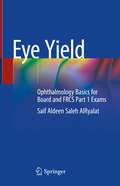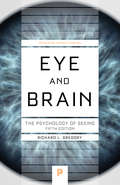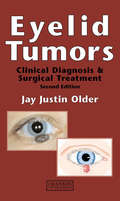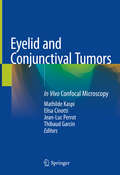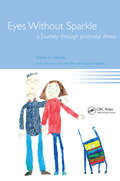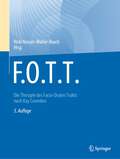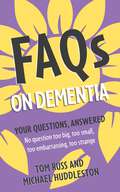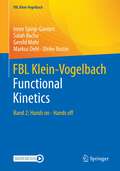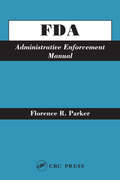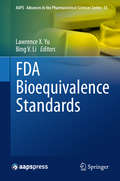- Table View
- List View
Eye Movements in the Critical Care Setting
by Aasef Shaikh Fajun WangThis book describes the abnormal eye movements encountered in the critical care unit in everyday practice and elaborates on the mechanism and clinical significance behind them. Beginning with a thorough grounding of the basic anatomy and physiology ocular motor system and how they move the eyeballs; chapters explore the pathological descriptions of all the signs that a practicing neurologist, ophthalmologist, or emergency medicine specialist might see in other ICU's, as well as the diagnostic and prognostic evidence to answer the consult questions. Further chapters describe the abnormal ocular movements seen in the Neuro-ICU, Eye Movements in the Critical Care Setting is a comprehensive resource on eye movement in the critical care setting, and a useful guide for the neurologist, ophthalmologist, and emergency medical specialist and residents alike.
Eye Pathology
by Steffen Heegaard Hans GrossniklausThis book is a comprehensive, in-depth, and up-to-date resource on eye pathology that will be of great practical value for ophthalmic and general pathologists and ophthalmologists. Congenital abnormalities, inflammatory conditions, infections, injuries, degenerative diseases, and tumors are all covered with the aid of more than 700 images. In the case of tumors, the wide variety of neoplasms that occur in the eyelid, conjunctiva, retina, uveal tract, lacrimal gland and sac, orbit, and optic nerve are comprehensively reviewed, and the most recent knowledge on the relation between genetics and prognosis is presented. Entries on specific diseases are organized in a standard way, with information on etiology, epidemiology, clinical presentation, pathological characteristics, differential diagnosis, therapy, and prognosis. The authors are all recognized experts and members of the European and American ophthalmic pathology societies.
Eye Tracking: Background, Methods, and Applications (Neuromethods #183)
by Samuel StuartThis volume explores the latest eye-tracking methodologies that help researchers understand the background, methods, and applications involved in these studies. The chapters in this book cover topics such as methods and models of eye-tracking in natural environments; natural gaze informatics (i.e., assisted wheelchair mobility); eye-tracking application to understand the visual control of locomotion; eye movement in neurological disorders; and eye movements in sports research and practice. In the Neuromethods series style, chapters include the kind of detail and key advice from the specialists needed to get successful results in your laboratory. Cutting-edge and practical, Eye Tracking: Background, Methods, and Applications is a valuable resource for experienced and novice researchers interested in learning more about this field and its future developments.
Eye Yield: Ophthalmology Basics for Board and FRCS Part 1 Exams
by Saif Aldeen AlRyalatThe book provides high yield information in basic ophthalmology including anatomy, physiology, pathology, pharmacology, microbiology, and embryology that are required for preparation of ophthalmology exams. The book focusses on all parts of the eye, with special focus on basic science including appropriate amount of information on clinical science for students and trainees. It is written in a lucid manner with textual notes and illustrations for quick learning and better understanding. Each section contains high yield information in separate points, with commonly asked information in “Eye Yield Note” boxes. It also includes estimated study time for each section to better plan the study. It also includes a pre-exam night study section at the end of the book that provides the information to be reviewed just before the exam. The book will be very helpful in passing almost all basic ophthalmology exams in a relatively short study time, by skipping the “filling” text available in most of the textbooks. It will be an excellent read for post graduate students looking for concise revision material. It will be relevant for medical students, ophthalmology residents, and medical doctors applying for ophthalmology residency and also for FRCS Part 1 exam.
Eye and Brain: The Psychology of Seeing
by Richard L. GregorySince the publication of the first edition in 1966, Eye and Brain has established itself worldwide as an essential introduction to the basic phenomena of visual perception. Richard Gregory offers clear explanations of how we see brightness, movement, color, and objects, and he explores the phenomena of visual illusions to establish principles about how perception normally works and why it sometimes fails. Illusion continues to be a major theme in the book, which provides a comprehensive classification system. There are also sections on what babies see and how they learn to see, on motion perception, the relationship between vision and consciousness, and on the impact of new brain imaging techniques. sentation of the text and illustrations has been improved by the larger format and new page design. The thousands of readers of the previous editions of Eye and Brain will find this new revised edition even more attractive and enthralling.
Eye and Brain: The Psychology of Seeing (Fifth edition)
by Richard L. GregorySince the publication of the first edition in 1966, Eye and Brain has established itself worldwide as an essential introduction to the basic phenomena of visual perception. In this book, Gregory offers clear explanations of how we see brightness, movement, color, and objects, and he explores the phenomena of visual illusions to establish principles about how perception normally works and why it sometimes fails. Although successive editions have incorporated new discoveries and ideas, this is the first time that Richard Gregory has completely revised and updated the text, adding more than thirty new illustrations. The phenomena of illusion continue to be a major theme in the book, in which the author makes a new attempt to provide a comprehensive classification system. There are also new sections on what babies see and how they learn to see, on motion perception, and tantalizing glimpses of the relationship between vision and consciousness and of the impact of new brain imaging techniques. In addition, the presentation of the text and illustrations has been improved by the larger format and new page design. The thousands of readers of the previous editions of Eye and Brain will find this new revised edition even more attractive and enthralling.
Eye of the Beholder: 'A haunting tale of intrigue' –Emily Freud
by Emma Bamford'Eerie, atmospheric' Louise Jensen'A haunting tale of intrigue' Emily Freud'Ruth Ware fans will eat this up' Publishers WeeklyIf beauty is in the eye of the beholder, how much can you trust what you see? When Maddy Wight is hired to ghostwrite the memoir of world-renowned cosmetic surgeon Angela Reynolds, she jumps at the chance to get her career back on track. But the deeper she digs, the more elusive the doctor becomes. Confined to Angela&’s glass-walled house in the Scottish Highlands, Maddy can&’t shake the unsettling feeling of being watched. As a result, she is drawn ever closer to Angela&’s enigmatic business partner Scott, whose mercurial moods change as quickly as the darkening moors outside. Returning to London once the book is finished, Maddy is excited for their future together. But news of Scott&’s death shatters the celebrations at the book&’s launch party. Which is why, months later and still grieving, she is blindsided to see Scott entering a tube station just in front of her. And before she knows it, she is following him. In this reimagining of Hitchcock&’s Vertigo, jeopardy can be lurking where you least expect it…Praise for Emma Bamford 'Powered by a subtle, ominous tension. I loved this book&’ LEE CHILD &‘Paradise never felt so sinister&’ RUTH WARE &‘An incredible debut&’ B A PARIS &‘Suspenseful, evocative and beautifully written, I devoured it&’ L V MATTHEWS &‘That most exciting psychological thriller in which the darkest dangers lurk in a suspicious mind and a guilty heart&’ A J FINN &‘Gripping and pacy... A perfect summer read&’ IMRAN MAHMOOD &‘A debut thriller that unfolds with the inexorable force of a nightmare&’ JOHN CONNOLLY 'Had me gripped. I loved the subtle, sinister sense of tension that built through the book' BETH O'LEARY 'An amazing and evocative atmosphere of paradise that quickly turns sinister! A must summer read for all crime fans' VICKI BRADLEY
Eyelid Surgery: A Fresh Perspective on Correcting Common Conditions
by Vladimir ThallerThis book is a practical guide for anyone who performs eyelid surgery, whatever their specialty, and is particularly relevant for ophthalmologists in training and non-oculoplastic surgeons who may venture into this field. The step-wise text is supported by numerous original illustrations. It emphasises a logical, minimalist approach to lid surgery and challenges some popular practices. The novel techniques unique to this volume may be of interest to experienced oculoplastic surgeons. They include emphasis on the superiority of Meibomian orifice line lid traction suture placement over using the grey line. This makes bolsterless suture tarsorrhaphy a viable and better alternative to temporary surgical tarsorrhaphy. Maximal use of direct closure and directed laissez-faire encourages tissue expansion in eyelid reconstruction, aided greatly by the placement of a magic suture. The seductively simple medial canthal thermoplasty corrects medial lid laxity without dissection. The control of active thyroid eye disease with orbital depot steroid injections, the importance of full orbital volume replacement after eye removal and the superiority of modified Bick lid margin resection over the lateral tarsal strip for lid tightening are further departures from traditional practice.
Eyelid Tumors
by Arnab BiswasEyelid tumors are commonly encountered by oculoplastic as well as plastic surgeons. The challenge of managing these cases lies not only in performing the surgery in a precise manner in small area, but also in ensuring a visually-appealing cosmetic outcome. This is an innovative and concise portable handbook that guides the surgeons on how to approach and manage these cases in a step-by-step manner. Each chapter of this practical guidebook has outstanding illustrations drawn in full color clearly showing each incision line, flap management, suture placement and its technique and the expected cosmetic outcome. When a lid tumor is excised, there is a tissue defect that needs to be corrected. Ophthalmologists and plastic surgeons will find this work an excellent reference material to solve the jigsaw puzzle of tissue defects in and around the periorbital region. Importantly, they can quickly refer to the images just before starting a procedure. The author has first explained the anatomical aspects and anesthetic techniques for eyelid surgery, followed by review of the benign and malignant tumors, finally describing the flap creation and reconstruction techniques that are currently used in various lid tumors in an organized fashion.
Eyelid Tumors
by Jay Justin OlderThis book provides a practical, superbly illustrated guide to the clinical diagnosis of eyelid tumors and the surgical procedures used for tumor excision and eyelid reconstruction. In this completely revised and updated Second Edition, there are new chapters on pathology and radiosurgery, procedures have been amended to reflect current practice, al
Eyelid and Conjunctival Tumors: In Vivo Confocal Microscopy
by Mathilde Kaspi Elisa Cinotti Jean-Luc Perrot Thibaud GarcinThis Atlas gives the complete expert opinion on the diagnostic features of eyelid and conjunctival tumors (benign and malignant): a state-of-the-art guide with numerous images, useful for both dermatologists and ophthalmologists. This invaluable resource, illustrating clinical, histological and re fectance confocal microscopy features, first addresses the normal conditions of the ocular surface, then reviews lesions due to epidermal, melanocytic and adnexal tumors. A final part is devoted to conjunctiva conditions, from normal to malignant conjunctival tumors. The high number of illustrations and their description of many ocular surface lesions with in vivo confocal microscopy make this atlas an essential guide for the practitioners of both specialities.
Eyes Without Sparkle: A Journey Through Postnatal Illness
by Elaine HanzakOne day you will feel better… Eyes without Sparkle is a powerful medical autobiography describing the journey followed by the author into, through, and out of puerperal psychosis, the most severe form of postnatal depression. With vivid and intimate descriptions of events and the author’s feelings, this is the only book offering a single first-hand account of postnatal illness. The book serves as an inspiration for anyone suffering from or involved with a depressive illness. For health and social care professionals it is a reflective guide to learning from patients’ experiences, and the examples of positive and negative aspects of treatment can inform mental health services and policies.
F.O.T.T.: Die Therapie des Facio-Oralen Trakts nach Kay Coombes
by Ricki Nusser-Müller-BuschDieses praxisnahe Standardwerk vermittelt das bewährte interprofessionelle Therapiekonzept F.O.T.T. nach Kay Coombes. Im Mittelpunkt stehen die individuelle Förderung und Teilhabe von Patient*innen mit Dysphagie und Störungen der Atmung, der Stimme, des Sprechens und des Gesichtsausdrucks sowie die therapeutische Mundhygiene bei Schwerbetroffenen. Alle praxisrelevanten Themen zu Atmung, Stimme, Schlucken, Trachealkanülen-Management, Nahrungsaufnahme, Mundhygiene sowie die Behandlung von Patienten mit Fazialisparese und Kindern mit Zerebralparesen sind ausführlich beschrieben und durch zahlreiche Abbildungen veranschaulicht. Die 5. Auflage wurde grundlegend überarbeitet. Das ideale Praxis- und Fachbuch für die Logopädie, Ergotherapie, Physiotherapie, Pflege sowie für Ärzt*innen, die professionell das F.O.T.T.-Konzept im interprofessionellen Team umsetzen möchten. Auch hilfreich für pflegende Angehörige.
FAQs on Dementia
by Tom Russ Michael HuddlestonYou left the doctor's surgery before you could ask the things you really wanted to know.You've googled your question about dementia and had 75 answers, all contradicting each other.You asked your best friend - but they looked at you strangely.You have so many questions, but no idea where to start finding the answers. Here they are. In this book you'll find the definitive, expert responses to all your FAQs: On Dementia. No question is too simple, too embarrassing, too rude or too offbeat to be included, and each one has been asked by thousands of people just like you.Will my partner stop loving me now they have dementia?Does my mum have to go into a home now?Is dementia a terminal illness?All these questions, and hundreds more, are covered in this short but powerful, helpful, practical guide to understanding the nature, and impact, of dementia. Read at your leisure, or dip in and out when you most need the support or to shine a light on the issues and concerns that are making you uncomfortable or unhappy, and to bring them out of the shadows so you can understand and accept them.
FAQs on Dementia
by Tom Russ Michael HuddlestonYou left the doctor's surgery before you could ask the things you really wanted to know.You've googled your question about dementia and had 75 answers, all contradicting each other.You asked your best friend - but they looked at you strangely.You have so many questions, but no idea where to start finding the answers. Here they are. In this book you'll find the definitive, expert responses to all your FAQs: On Dementia. No question is too simple, too embarrassing, too rude or too offbeat to be included, and each one has been asked by thousands of people just like you.Will my partner stop loving me now they have dementia?Does my mum have to go into a home now?Is dementia a terminal illness?All these questions, and hundreds more, are covered in this short but powerful, helpful, practical guide to understanding the nature, and impact, of dementia. Read at your leisure, or dip in and out when you most need the support or to shine a light on the issues and concerns that are making you uncomfortable or unhappy, and to bring them out of the shadows so you can understand and accept them.
FAQs on Menopause
by Julie Robinson- You left the doctor's surgery before you could ask the things you really wanted to know.- You've googled your question about menopause symptoms and had 75 answers, all contradicting each other.- You asked your best friend - but they looked at you strangely.You have so many questions, but no idea where to start finding the answers. Here they are. In this book you'll find the definitive, expert responses to all your FAQs: On Menopause. No question is too simple, too embarrassing, too rude or too offbeat to be included, and each one has been asked by thousands of people just like you.Do people know I'm having a hot flush?Is it normal to feel rage all the time?Why I am getting more hair in some places and losing it from others?All these questions, and hundreds more, are covered in this short but powerful, helpful, practical guide to managing your menopause symptoms. Read at your leisure, or dip in and out when you most need the support or to shine a light on the problems and feelings that are making you uncomfortable or unhappy, and to bring them out of the shadows so you can understand and accept them.
FAQs on Menopause
by Julie Robinson- You left the doctor's surgery before you could ask the things you really wanted to know.- You've googled your question about menopause symptoms and had 75 answers, all contradicting each other.- You asked your best friend - but they looked at you strangely.You have so many questions, but no idea where to start finding the answers. Here they are. In this book you'll find the definitive, expert responses to all your FAQs: On Menopause. No question is too simple, too embarrassing, too rude or too offbeat to be included, and each one has been asked by thousands of people just like you.Do people know I'm having a hot flush?Is it normal to feel rage all the time?Why I am getting more hair in some places and losing it from others?All these questions, and hundreds more, are covered in this short but powerful, helpful, practical guide to managing your menopause symptoms. Read at your leisure, or dip in and out when you most need the support or to shine a light on the problems and feelings that are making you uncomfortable or unhappy, and to bring them out of the shadows so you can understand and accept them.
FBL Klein Vogelbach Functional Kinetics: Band 2: Hands on - Hands off (FBL Klein-Vogelbach)
by Irene Spirgi-Gantert Gerold Mohr Markus Oehl Salah Bacha Ulrike RostinDie vier bewährten Lehr- und Praxisbücher der Funktionellen Bewegungslehre zu Grundlagen, therapeutischen Übungen, Ballübungen und Behandlungstechniken kompakt in zwei Bänden zusammengefasst! Mit Band 1 „Untersuchen und Behandeln“ und Band 2 „Hands on – Hands off“ sind Sie perfekt gerüstet! Physiotherapeuten finden in Band 2 die Prinzipien zu allen wesentlichen Techniken und Übungen der Funktionellen Bewegungslehre, über 40 Übungen und neue funktionelle Tests für das Überprüfen von Mobilität, Elastizität, Stabilität, Bewegungsdissoziation und Koordination. Wie sieht der klinische Denk- und Entscheidungsprozess von Hands-on zu Hands-off aus? Wie muss das funktionelle Training aufgebaut werden, damit ein müheloser Transfer in den Alltag gelingt? Welche Bewegungschoreografien fördern die Interaktion der Körperabschnitte untereinander optimal? Erfahrene FBL-Instruktoren beantworten Ihnen diese Fragen! Aus dem Inhalt · Grundparameter der Bewegungsökonomie · Neurofunktionelle Tests · Mobilisierende Massage, hubfreie und widerlagernde Mobilisation und funktionelle Übungen mit und ohne Ball · Training von Bewegungskontrolle und Geschicklichkeit aller Körperabschnitte Plus: Videos und Handouts veranschaulichen die praktische Umsetzung optimal! Nutzen Sie die bewährten und ständig weiterentwickelten Methoden der FBL und lernen Sie, die körperlichen Ressourcen Ihrer Patienten optimal zu fordern und zu fördern.
FBL Klein-Vogelbach Functional Kinetics Die Grundlagen
by Irene Spirgi-Gantert Barbara SuppéVon B. Werbeck und I. Spirgi-Gantert völlig neu bearbeitet und inhaltlich wie formal rundum modernisiert: - besser lesbar und leichter zugänglich - mit farbigen Lernhilfen und Zeichnungen - praxisbezogen durch zahlreiche Beispiele - Neu: Grundlagen der Gangschulung und Ausblicke auf Behandlungstechniken und Übungen Als Standardwerk in der Physiotherapie leitet es Therapeuten in der Ausbildung an, o normale und von der Norm abweichende Bewegung und Haltung präzise zu beobachten, o dem Patienten in der Behandlung richtiges Bewegungsverhalten zu vermitteln und o seine aktive Wahrnehmung dafür zu schulen.
FBL Klein-Vogelbach Functional Kinetics Die Grundlagen: Bewegungsanalyse, Untersuchung, Behandlung
by Barbara SuppéVon B. Werbeck und I. Spirgi-Gantert völlig neu bearbeitet und inhaltlich wie formal rundum modernisiert:- besser lesbar und leichter zugänglich- mit farbigen Lernhilfen und Zeichnungen- praxisbezogen durch zahlreiche Beispiele- Neu: Grundlagen der Gangschulung und Ausblicke auf Behandlungstechniken und ÜbungenAls Standardwerk in der Physiotherapie leitet es Therapeuten in der Ausbildung an,o normale und von der Norm abweichende Bewegung und Haltung präzise zu beobachten,o dem Patienten in der Behandlung richtiges Bewegungsverhalten zu vermitteln undo seine aktive Wahrnehmung dafür zu schulen.
FBL Klein-Vogelbach Functional Kinetics praktisch angewandt: Brustkorb, Arme und Kopf untersuchen und behandeln
by Barbara Suppé Matthias BongartzIn der Buchreihe wird detailliert dargestellt, wie die Übungen und Behandlungstechniken der FBL/Functional Kinetics an und mit den Patienten angewandt werden können. Diese "Gebrauchsanleitung" für die Arbeit mit dem FBL-Instrumentarium gliedert sich jeweils in Untersuchung und problemorientierte Behandlung. Jeder der drei Bände thematisiert die Körperabschnitte, die als funktionelle Einheiten betrachtet und therapiert werden, bzw. therapierelevante Bewegungsabläufe: Becken und Beine (1); Brustkorb, Arme, Kopf (2); Gehen, Sitzen, Bücken (3).
FBL Klein-Vogelbach Functional Kinetics: Band 1: Untersuchen und Behandeln (FBL Klein-Vogelbach)
by Irene Spirgi-Gantert Gerold Mohr Markus Oehl Tiziana Grillo Salah Bacha Ulrike RostinDie vier bewährten Lehr- und Praxisbücher der Funktionellen Bewegungslehre zu Grundlagen, therapeutischen Übungen, Ballübungen und Behandlungstechniken kompakt in zwei Bänden zusammengefasst! Mit „Untersuchen und Behandeln“ und „Hands on – Hands off“ sind Sie perfekt gerüstet! Dieses Buch liefert Physiotherapeuten die Grundlagen und alle wesentlichen Techniken der Funktionellen Bewegungslehre. Welchen Einfluss hat die Schwerkraft auf Haltung und Bewegung? Welche Bewegungen des täglichen Lebens sollten während des Befundes überprüft werden? Und wie genau funktioniert eigentlich der „Flamingo“? Die Experten beantworten Ihnen diese Fragen! Aus dem Inhalt· Basics zu Myofaszien, Bewegung, Haltung und motorischem Lernen· Untersuchung, u.a. mit Blick auf Konstitution, Beweglichkeit, Statik und ADL· Mobilisierende Massage, hubfreie und widerlagernde Mobilisation und funktionelle Übungen mit und ohne Ball Plus: Videos und Handouts veranschaulichen die praktische Umsetzung optimal! Nutzen Sie die bewährten und ständig weiterentwickelten Methoden der FBL und lernen Sie, die körperlichen Ressourcen Ihrer Patienten optimal zu fordern und zu fördern.
FDA Administrative Enforcement Manual
by Florence R. ParkerWhen a problem arises with a product regulated by FDA, the Agency can take a number of actions to protect the public health. Initially, the agency works with the manufacturer to correct the problem voluntarily. If that fails, administrative enforcement and legal remedies include asking the manufacturer to recall a product and having federal marshal
FDA Bioequivalence Standards
by Lawrence X. Yu Bing V. LiThis comprehensive reference provides an in-depth discussion on state-of-the-art regulatory science in bioequivalence. In sixteen chapters, the volume explores a broad range of topics pertaining to bioequivalence, including its origin and principles, statistical considerations, food effect studies, conditions for waivers of bioequivalence studies, Biopharmaceutics Classification Systems, Biopharmaceutics Drug Disposition Classification System, bioequivalence modeling/simulation and best practices in bioanalysis. It also discusses bioequivalence studies with pharmacodynamic and clinical endpoints as well as bioequivalence approaches for highly variable drugs, narrow therapeutic index drugs, liposomes, locally acting gastrointestinal drug products, topical products and nasal and inhalation products. FDA Bioequivalence Standards is written by FDA regulatory scientists who develop regulatory policies and conduct regulatory assessment of bioequivalence. As such, both practical case studies and fundamental science are highlighted in these chapters. The book is a valuable resource for scientists who work in the pharmaceutical industry, regulatory agencies and academia as well as undergraduate and graduate students looking to expand their knowledge about bioequivalence standards.
FDA Regulatory Affairs: A Guide for Prescription Drugs, Medical Devices, and Biologics
by Douglas J. Pisano David S. MantusExamines harmonization of the US Federal Food, Drug, and Cosmetic Act with international regulations as they apply to human drug and device development, research, manufacturing, and marketing. The Second Edition focuses on the new drug approval process, cGMPs, GCPs, quality system compliance, and corresponding documentation requirements. Written in



